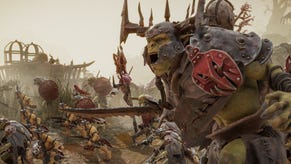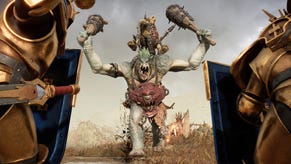Warhammer Age Of Sigmar: Realms Of Ruin review: a decent RTS heavy on micromanagement
But too fussy for a dummy like me
I feel like I can let a lot of you know whether you'd like Warhammer Age Of Sigmar: Realms Of Ruin with just a few words: it's about micromanagement. Victory is dependent on rapidly issuing movement, attack and ability commands to several small squads of soldiers, and your units will pay a heavy price if your attention leaves them for more than a few moments.
If that's not your thing, move along. If it is, Realms Of Ruin is a solid, button-down war 'em up and you should read on.
Using the setting from Warhammer Fantasy sequel Age Of Sigmar, Realms Of Ruin lets you play as four factions: Stormcast Eternals, Orruk Kruleboyz, Nighthaunt and the Disciples Of Tzeentch. Of the bunch, the human Stormcast Eternals are your likely starting point, as they're medieval knights with mostly human units that are easily recognisable.
Recognisability is important because Realms Of Ruin splits all its units into four categories and shapes combat via a rock-paper-scissors system. Melee beats armour, armour beats ranged, and ranged beats melee. There are icons above each retinue's head to tell you which is which, but it doesn't hurt when you can also see your ranged Stormcast soldier carrying a bow. Named characters like Sigrun and Demechrios are heroes, fitting into that fourth unit type on the battlefield. They aren't part of the combat triangle of the others - that would make it a combat square, geometry fans - but they have particular strengths, including special abilities, that can turn the tide of a fight.
The Stormcast Eternals are also your intro to Realms Of Ruin's campaign. In between-mission cutscenes and in-mission dialogue, you'll get to know shiny gold soldiers Sigrun and Iden and magic boy Demechrios. Or, you'll get to hear them talk a lot, at least. There's little resembling a personality between them, and their pompous speechifying about artefacts and prophecy makes them a tough hang.
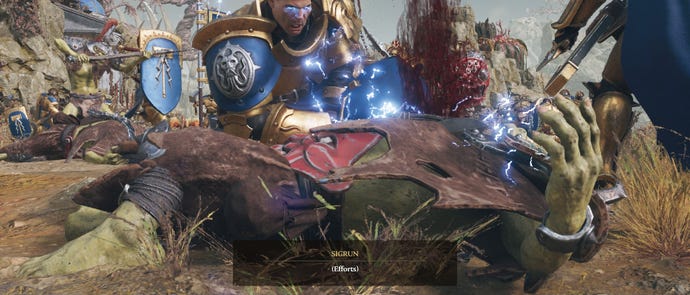
Alas, it's tough hangs all the way down in the campaign, as the several missions in which you control the Orruk Kruleboyz and Disciples Of Tzeentch are similarly one-note, replacing "pompous" and "speechifying" with "angry" and "shouting". This probably seems like an odd complaint - this is Warhammer, they're Orruks, etc. - but the bits of Fantasy or 40K I like tend to have at least some humour to them and that's entirely absent here. Plus, character motivations and clear stakes are fundamental tenets of good writing, and that holds true whether or not your characters look like they're cosplaying Ferrero Rochers.
Writing and Rochers aside, victory in multiplayer matches and several campaign missions is achieved by holding more capture points than your opponents until they run out of tickets. You'll also need to capture and hold build points, on which you can place structures that grant you the resources necessary for training new units, using special abilities, and unlocking upgrades to buildings and units.
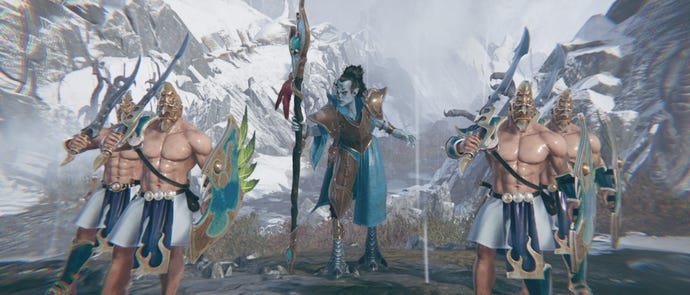
This is where micro makes the difference. Until you upgrade your HQ, you might only have six squads of soldiers - hero units are a squad unto themselves - and so victory is dependent on utilising the combat triangle and manual activation of unit abilities. Sending an armoured unit against a melee unit is a sure way to see them destroyed, with an expensive and slow process to then deploy replacements back at your base and traipse them back to the frontline.
Units do almost nothing if not directly told. If a melee fighter is being shot from a modest distance by a man with a bow, they'll just stand and take it until they die, or until you tell them to move or fight back. That's perfectly reasonable, but your attention is going to be split across multiple capture points, build points and skirmishes as you juggle units, special abilities, construction, and more. I found it overwhelming at times, particularly in the fifth campaign mission when all of these systems were in play at once for the first time. I've been playing real-time strategy games for 30 years, which means I'm experienced but also decrepit. I had a better time once I dropped the difficulty down from Medium to Easy, but if I'm honest what I really wanted was a pause button during which I could issue commands and survey the battlefield.
Some of the campaign's best missions are those that break free of the capture-and-hold system. In one, you take control of the Na'vi's twisted cousins, the Tzeentch, mutated magic cultists who make for a fun army, and must rapidly construct a tower defense route. In another, you lead Sigrun on a rampage behind enemy lines, with no soldiers except those you rescue en route towards a fight against a single, taunting Orruk.
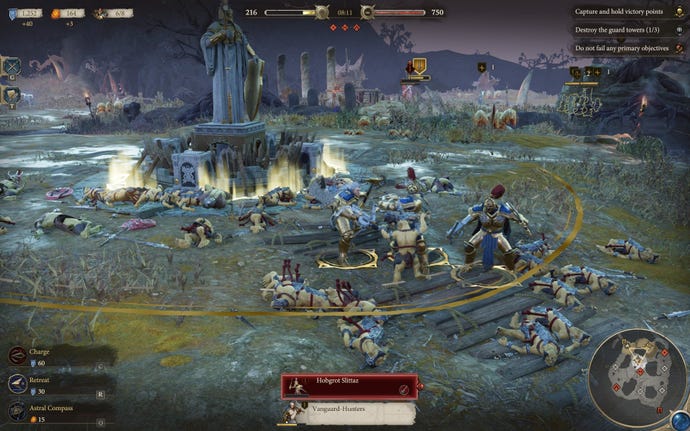
Other mission twists are less successful. In one, you're charged with leading Orruks on a stealth raid to burn down three Stormcast granaries, with an instant mission fail if the fire-starting Orruk dies. Your units have some stealth abilities, but I failed this mission twice because the fire-starting Orruk auto-attacked a nearby enemy, alerting everyone, and once because my squad was spotted by a guard tower while my control was stolen away by an unskippable in-mission cutscene. Even if I was to blame for these failures, being sent back to the start of the mission to repeat the process is unequivocally bad.
Where the capture-and-hold system succeeds is in creating tense stalemates in which you control half of a map and your enemy the other, and there's a clearly contested chokepoint to focus the fight around. In these moments, the fight is less about clicking the fastest and more about making the right choices in how you focus your fighters on the correct enemy, or about managing your economy and upgrades efficiently enough that you eventually turn up with the superior force. I particularly relished the latter. Once you've lost man after man against mixed squads of Orruks defending a capture point, showing up with the Stormdrake Guard, a fire-breathing dragon, and burning them to a crisp feels earned.
I wish the campaign let me kick loose with these bombastic thrills more often. I've only managed to get a couple of multiplayer matches in - and both against the game's developers, so hardly representative - but I got the sense even in the campaign that Realms Of Ruin is a strategy game balanced for multiplayer play. Powerful endgame units are therefore limited by the upgrades needed to unlock them, the resources and time it creates to deploy them, and the combat triangle that incentivises you to have a mixture of units in your army at all times. I'd have been having more fun if, at least a couple of times, it had let me have a swarm of bird giants to go smash up some enemies with.
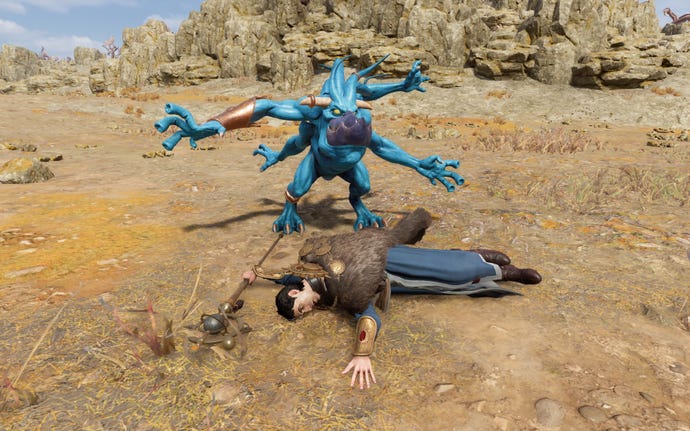
Hopefully by this point you've come to realise the true meaning of that paragraph up top: it's me, I'm the guy who isn't into micromanagement. My favourite real-time strategy games involve careful base construction and economy management, as in Supreme Commander, or building large, varied armies and then blithely smashing them into the enemy in a swarm, as you can viably do in Command & Conquer. Realms Of Ruin isn't about those things, and I found its combat triangle and reliance on manual special abilities restrictive, overwhelming, and a little fussy.
That doesn't mean it's not for you, however. Strip those personal complaints away and Realms Of Ruin is a solid RTS with some fun units and missions. Even if I do still think you'll find the Stormcast Eternals boring.
This review is based on a review build of the game provided by Frontier Developments.



